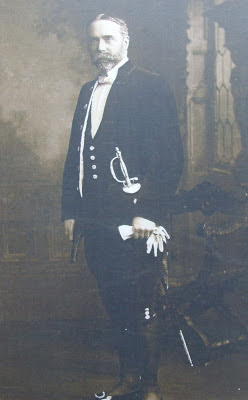James Joyce, Holles Street and Sir Andrew Horne
As Bloomsday approaches it
seems an apt time to look at one early twentieth century obstetrician who makes
a fleeting appearance in Ulysses. The
National Maternity Hospital, Holles Street, is the setting for a chapter in the
second half of the book, later named ‘the Oxen of the Sun’, which contains a
philosophical discussion on the origins of life, pregnancy, childbirth and
abortion. Joyce refers to Holles Street as ‘the house of Horne’, a play on the
name of the Joint Master of the hospital Andrew Horne.
 |
| Sir Andrew Horne (VM/1/2/H/35) |
Andrew John Horne was born in
Ballinasloe, county Galway in 1856, he was educated at Clongowes Wood College
before studying medicine at the Carmichael School of Medicine in Dublin, and
graduating as Licentiate of the RCSI in 1877 and RCPI the following year.
Specialising in obstetrics Horne initially worked at the Rotunda Hospital, in
1894 on the establishment of Holles Street Hospital Horne was appointed Joint
Master with Patrick Barry, a position Horne held for 30 years. Horne became a
member of the College of Physicians in 1881 and a Fellow in 1885, he was
President of the College from 1908-1910.
Although immortalised in
literature, it seems that Horne was not a fan of Joyce’s work, and never had
the book in his house. According to the Horne family Andrew Horne had turned
Joyce out of the Maternity Hospital in 1904, when Joyce was a student, for an
offensive remark to the patients about ‘the poor breeding like rabbits'.[1] How
much of this recalled incident is true is unclear.
In Ulysses while Bloom is talking to Nurse Callan on Holles Street he
is recognised by a junior medical officer Dr Dixon, who invites him into the
doctor’s common room. There a group of medical students discuss the ethics of
saving a mother’s life over that of the baby, as well as ribald songs from
‘Punch’ Costelle. The scene in Ulysses is very similar to one in Oliver St John
Gogarty’s novel Tumbling in the Hay,
Gogarty himself had undertaken a course of midwifery lectures in Holles Street
as a student in 1903, and it may well have been during this time that Joyce
visited Holles Street.
 |
| TCD medical students, c.1920 (FJO/8) |
Andrew Horne may not have
appreciated Joyce’s nod to his professional position, but in 1913 he received
official recognition of his contribution to medicine when he was awarded a
knighthood for his services to Holles Street and the Royal College of
Physicians of Ireland. On 5th July 1913 RCPI wrote to Dr Horne to
congratulate him and inform him of the College resolution passed that day:
Resolved: that the President
and fellows of the College offer most hearty congratulations to Sir Andrew
Horne on the honour of knighthood which his majesty has been pleased to confer
upon him, and they trust that he may long be spared to enjoy the well-merited
distinction. (AJH/4/1)
The Horne family have recently
donated a number of items to the RCPI Heritage Centre, including a photograph
album from the Phagocytes Club and the suit and sword worn by Sir Andrew on receving
his knighthood.
 |
| Sir Andrew Horne, 1913 (AJH/4/4) |
Footnotes
[1] Farmer, Tony, Holles Street
1894-1994. The National Maternity Hospital. A Centenary History (Dublin, 1994),
pp.208-9.